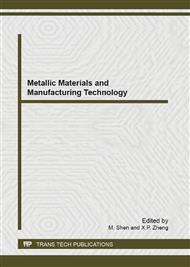p.59
p.63
p.67
p.71
p.75
p.80
p.84
p.88
p.92
Molecular Dynamics Simulation Study of Grinding Process of Mg-Al Alloy
Abstract:
A molecular dynamics simulation considered of chip deformation and force analysis for grinding process of Mg-Al alloy is presented. Hybrid potentials including embedded atom method (EAM) potential and Morse potential are applied in this model. The activities among atoms of Mg-Al Alloy material is described by EAM potential which is very suitable for metal materials. Morse potential is used to realize the interaction between Mg-Al alloy and abrasive grain made of diamond. Simulations of Different depths of cut (0.6nm, 0.8nm and 1.0nm) and different cut speeds (50m/s, 100m/s and 200m/s) are given. The experience result shows that with the same nanometric depth of cut, there is a little difference of ratio of the cut potential to the cutting speed. Moreover, with the same cutting speed, the cut potential is increased linearly with the depth of cut while reaching to stable cutting regime.
Info:
Periodical:
Pages:
75-79
Citation:
Online since:
September 2013
Authors:
Keywords:
Price:
Сopyright:
© 2013 Trans Tech Publications Ltd. All Rights Reserved
Share:
Citation:


